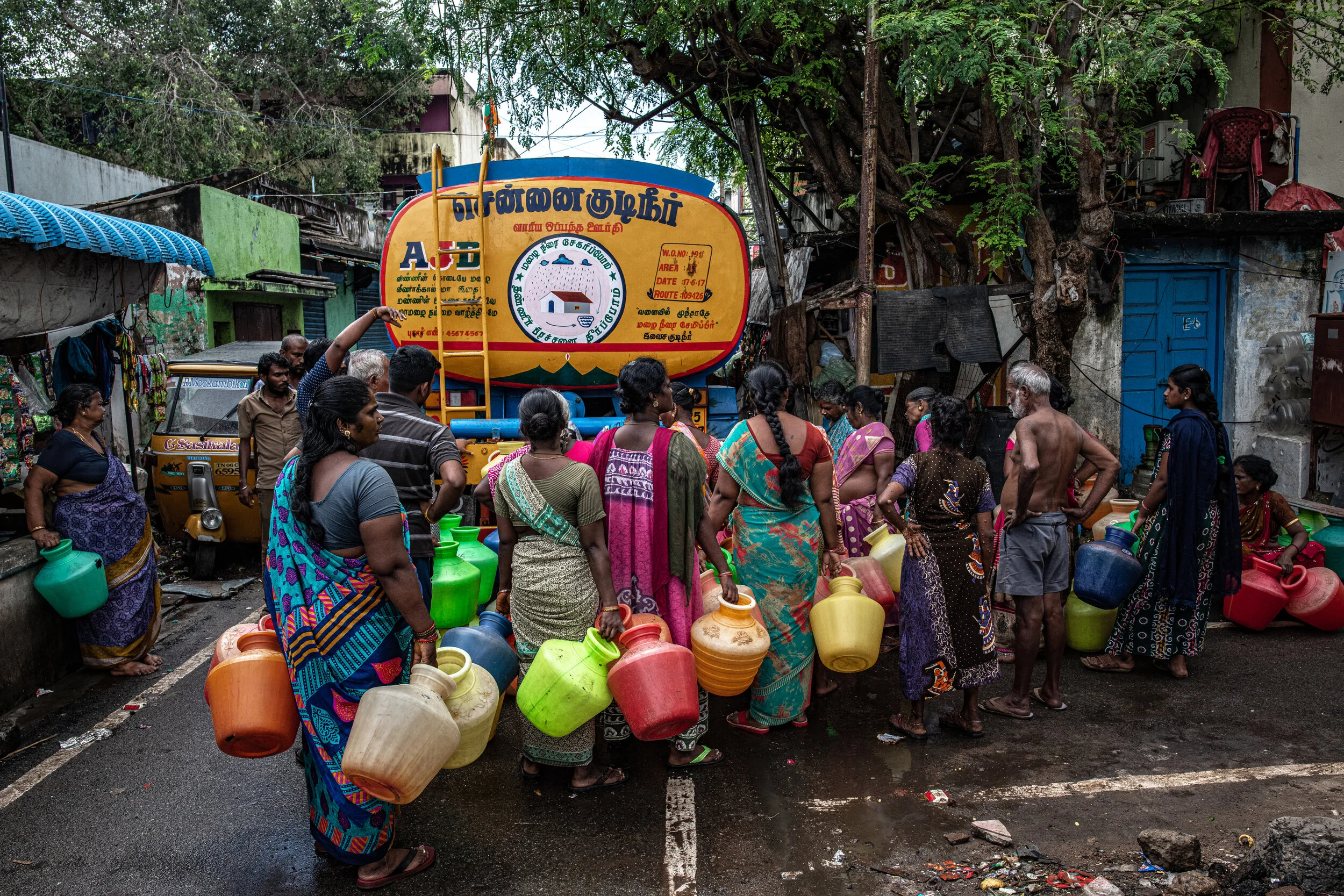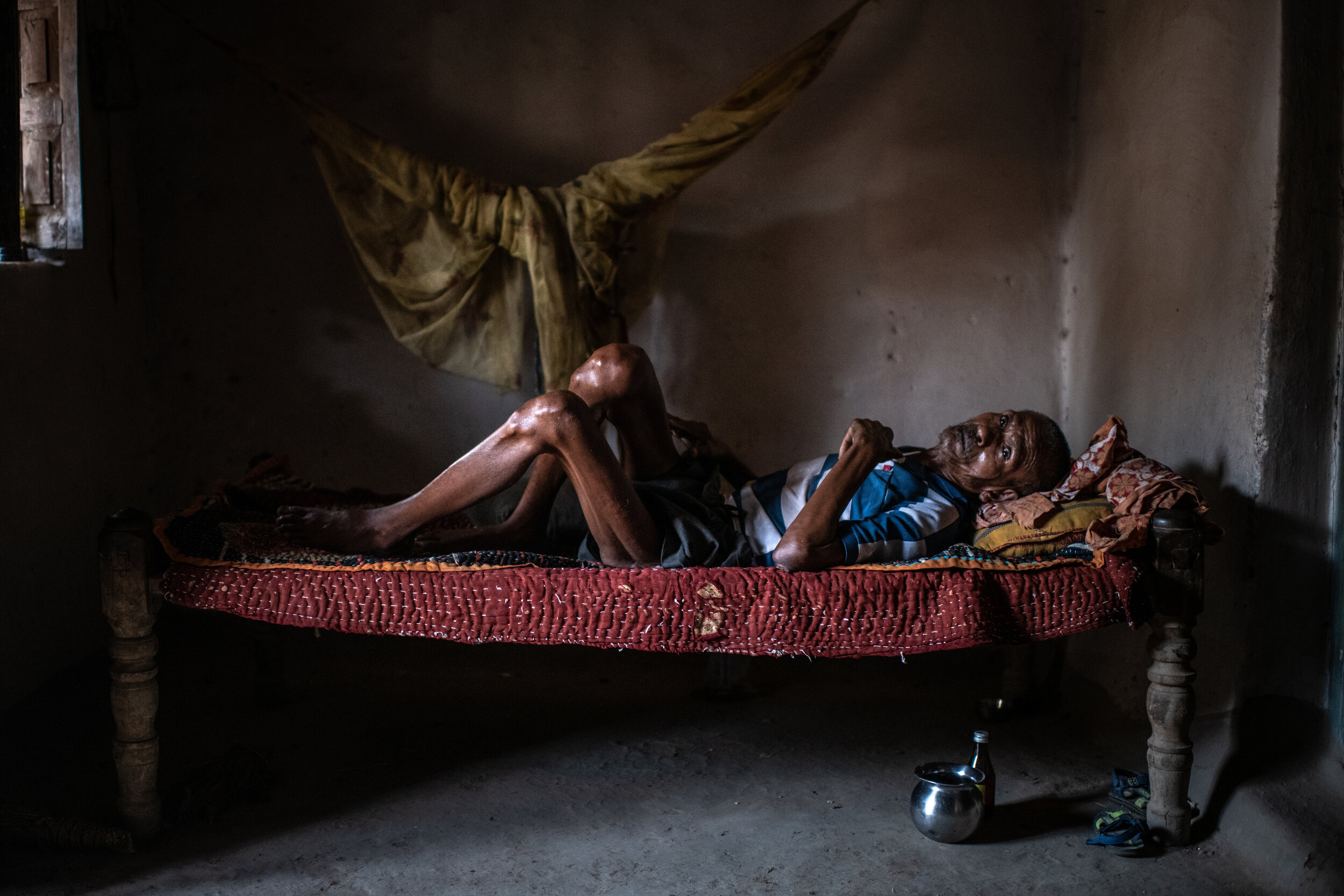
















8/4/2019 Mumbai, India.
A man walked through a flooded street in the Sion neighborhood of Mumbai, along the banks of the Mithi River, in early August. Mumbai, a megacity of over 15 million is particularly vulnerable to rising sea levels, and is criss crossed by fresh waterways, like the Mithi, which empties into Mumbai’s natural harbor. In 2005, the river broke it’s banks during heavy rainfall, flooding some of the most populated areas of the city, and killing over 1000.

6/14/2019 Charam, Uttar Pradesh, India.
A young resident of Charam walked across the cracked dry earth of a small pond in the village of Charam, Uttar Pradesh, where during the hot months, some of the hand pumps run dry.
Residents of the Chopan Block in Uttar Pradesh, about 120km south of Varanasi, used to grow Lentils and Mustard and other grains with the rainwater that fell and refreshed the small ponds amid forested hills that locals say were home to monkeys and wild pigs decades ago. Today, the district is red and brown parched landscape, with Mahua trees and their deep roots the only vegetation that stays green year round. Many locals have stopped planting crops all together because they know that the rains are no longer sufficient to support their crops. Those who do grow can plant just once a year, and they take longer to grow due to the lack of water. Handpumps for drinking water run dry in the summer months, forcing residents to walk ever greater distances to fill their buckets and jugs. The only thing sustaining the community, according to locals, is the money sent back from young villagers who have migrated to India’s rapidly expanding cities for work.

10/31/2019 Chennai, India
Residents lined up to collect drinking water from a tanker truck during a distribution in the Mylapore neighborhood of north Chennai in late October. Earlier this year, Chennai was in the news around the world as reservoirs, and residents taps, ran dry in the city and water had to be shipped in by train.

6/11/2019 Near Chak Ela, Uttar Pradesh, India.
Sakto Pal, 69, prepared to inject one of his sick sheep as they grazed on dry fields near Chak Ela, Uttar Pradesh. Mr. Pal said that over the last 10 years, his herd has shrunk on average from 65 to around 50 sheep, and that today, many of the lambs die when the dry season comes. The adults, he says, get frequent fevers, which he works to stave off with injections of medication that he administers himself.

6/14/2019 Parshoi, Uttar Pradesh, India.
A resident of Parshoi looked into the overgrown well that dried up 2 years ago and never returned. The village where the elderly say berries used to grow now grows lentils once a year, if that’s even possible, due to an increasing lack of water in the area.
Residents of the Chopan Block in Uttar Pradesh, about 120km south of Varanasi, used to grow Lentils and Mustard and other grains with the rainwater that fell and refreshed the small ponds amid forested hills that locals say were home to monkeys and wild pigs decades ago. Today, the district is red and brown parched landscape, with Mahua trees and their deep roots the only vegetation that stays green year round. Many locals have stopped planting crops all together because they know that the rains are no longer sufficient to support their crops. Those who do grow can plant just once a year, and they take longer to grow due to the lack of water. Handpumps for drinking water run dry in the summer months, forcing residents to walk ever greater distances to fill their buckets and jugs. The only thing sustaining the community, according to locals, is the money sent back from young villagers who have migrated to India’s rapidly expanding cities for work.

6/15/2019 Jugail, Uttar Pradesh, India.
A woman burned dry husks to fertilize the land in Jugail, Uttar Pradesh in the hopes that the summer monsoon will bring rain to the region.
Residents of the Chopan Block in Uttar Pradesh, about 120km south of Varanasi, used to grow Lentils and Mustard and other grains with the rainwater that fell and refreshed the small ponds amid forested hills that locals say were home to monkeys and wild pigs decades ago. Today, the district is red and brown parched landscape, with Mahua trees and their deep roots the only vegetation that stays green year round. Many locals have stopped planting crops all together because they know that the rains are no longer sufficient to support their crops. Those who do grow can plant just once a year, and they take longer to grow due to the lack of water. Handpumps for drinking water run dry in the summer months, forcing residents to walk ever greater distances to fill their buckets and jugs. The only thing sustaining the community, according to locals, is the money sent back from young villagers who have migrated to India’s rapidly expanding cities for work.

6/16/2019 Raspahari, Uttar Pradesh, India.
Mishri Lal, 58, lay bedridden in his home in Raspahari. A carpenter by trade, Mr. Lal began to suffer stiffness in his legs 8-10 years ago but in the last five months has become unable to walk. Mr. Lal suffers from a condition that is common in the village and is thought to be the result of chemical contamination of their groundwater from the nearby Hindelco Alluminum plant.
Residents of the village of Raspahari, which is located 4km away from the Hindalco Alluminum manufacturing plant in Sonbhadra district, have been increasingly effected by muscular skeletal issues since the plants opening in the 1960’s. Many of them complain of stiff necks, and crushing back pain accompanied by stiffness. Legs that grow crooked as one enters middle age. Many of them in the water poor district that rely on hand pumps, say that visiting NGO’s have noted that they have high fluoride levels in their water, amid other pollutants that are thought to emanate from the nearby plant.

11/2/2019 New Delhi, India
A woman prayed amid bergs of toxic foam as Worshippers packed the banks of the heavily polluted Yamuna river during the festival of Chhath Puja. The river, which was once flowed with clear blue waters, is now a black soup of raw untreated sewage and industrial runoff, and is among one of the most heavily polluted rivers in the world. It eventually flows into the Ganges, joining India’s largest and most holy river as it snakes it’s way toward the Bay of Bengal.
India has always been subjected to the extremes of it’s climate, cycling between periods of drought, and extreme rainfall brought on by the monsoon. However, as the climate warms, and the monsoons annual cycle is disrupted, those extremes are getting more severe, leading to prolonged droughts and heavier flooding across the country—threatening India’s urban and rural areas alike.

8/8/2019 Delhi, India.
A resident of the Taimur Nagar neighborhood of New Delhi did his laundry amid a fetid mix of sewage and garbage that now clogs what used to be a natural creak that ran through the neigbhorhood—eventually emptying into the Yamuna river.
India’s capital, Delhi, was once criss-crossed by creaks that functioned as drains for the land into the Yamuna river. As Delhi as urbanized, many of these waterways, including the Barapullah, were paved over and converted into what effectively amount to open sewers. These small “drains” also used to contribute to the replenishment of the city’s aquifers, which today are running perilously low. Locals also report remembering a time when the Barapullah creek was full of fish, and clean enough to swim in. no more.

10/15/2019 Turkabad Kharadi, India
A resident of Turkabad Kharadi collected water from a well a few hundred yards from their village, which they use to do their laundry. The well, which fills during the monsoon, would soon run dry, they said.

10/20/2019 New Delhi, India
A resident of the Sanjay Colony neighborhood in New Delhi rushed with his water barrels as an early morning water delivery from a tanker truck was mobbed by his neighbors. As India’s cities swell with migrants from rural areas, many of whom are fleeing drought and the collapse of India’s small plot farming economy, they are stressing the municipal infrastructure and water resources of the very cities they are relocating to.

10/31/2019 Chennai, India
A resident of Chennai checked the pump and hose that is connected to the water barrels that feed water into his house, prior to a tanker truck delivery in late October. Earlier this year, Chennai was in the news around the world as reservoirs, and residents taps, ran dry in the city and water had to be shipped in by train.

8/4/2019 Mumbai, India.
Residents of the Sion neighborhood of Mumbai waded through heavy rain and fetid flood waters—a mix of monsoon rain water, waste from overwhelmed sewage systems and water from the swollen Mithi river with nowhere to go due to seasonal high tides, in early August. Mumbai, a megacity of over 15 million is particularly vulnerable to rising sea levels, and is criss crossed by fresh waterways, like the Mithi, which empties into Mumbai’s natural harbor. In 2005, the river broke it’s banks during heavy rainfall, flooding some of the most populated areas of the city, and killing over 1000.

8/4/2019 Mumbai, India.
A resident of the Sion neighborhood of Mumbai took refuge on top of a dumpster from rising flood waters—a mix of monsoon rain water, waste from overwhelmed sewage systems and water from the swollen Mithi river with nowhere to go due to seasonal high tides, in early August. Mumbai, a megacity of over 15 million is particularly vulnerable to rising sea levels, and is criss crossed by fresh waterways, like the Mithi, which empties into Mumbai’s natural harbor. In 2005, the river broke it’s banks during heavy rainfall, flooding some of the most populated areas of the city, and killing over 1000.

8/4/2019 Mumbai, India.
Shop keepers looked out on their flooded street during heavy monsoon rains in the Sion neighborhood of Mumbai, in early August. Mumbai, a megacity of over 15 million is particularly vulnerable to rising sea levels, and is criss crossed by fresh waterways, like the Mithi, which empties into Mumbai’s natural harbor. In 2005, the river broke it’s banks during heavy rainfall, flooding some of the most populated areas of the city, and killing over 1000.

8/6/2019 Delhi, India.
A man bathed in water spouting from a broken municipal water line along the Barapullah waterway in New Delhi in August. India’s capital, Delhi, was once criss-crossed by creaks that functioned as natural drains into the Yamuna river. As Delhi as urbanized, many of these waterways, including the Barapullah, were paved over and converted into what effectively amount to open sewers. These small “drains” also used to contribute to the replenishment of the city’s aquifers, which today are running perilously low. Locals also report remembering a time when the Barapullah creek was full of fish, and clean enough to swim in.